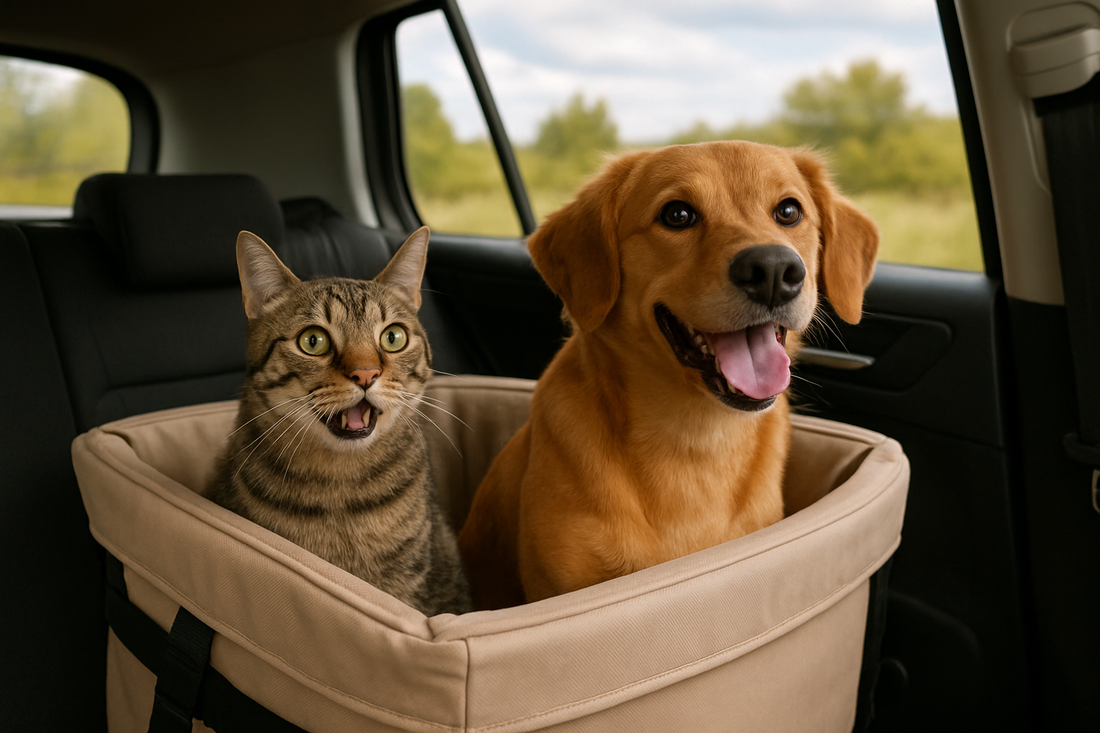
TRAVELLING WITH PETS: How to Make Every Journey Stress-Free
Traveling with your furry friend can be exciting — but without proper preparation, it can quickly turn stressful for both you and your pet. Whether it’s a short road trip to the countryside, a weekend getaway, or an international flight, traveling with pets doesn’t have to be ruff. With careful planning, the right gear, and a few helpful strategies, you can make the journey safe, smooth, and enjoyable for both you and your companion.
Here’s your complete guide to stress-free pet travel, from packing tips to anxiety management, enrichment ideas, and everything in between.
1. Plan Ahead
 Preparation is the cornerstone of a smooth trip. Start by:
Preparation is the cornerstone of a smooth trip. Start by:
- Checking Travel Policies: Airlines, trains, buses, and even ferries have different rules regarding pets. Confirm size limits, carrier requirements, fees, and documentation well in advance.
- Booking Pet-Friendly Accommodations: Not every hotel or Airbnb allows pets. Look for accommodations that welcome pets, have secure outdoor spaces, and provide pet-friendly amenities like water bowls or designated relief areas.
- Health Requirements: Ensure vaccinations, microchips, and parasite treatments are current. For international trips, check quarantine regulations and import/export rules.
- Emergency Planning: Research local veterinarians, animal hospitals, and pet supply stores along your route. Keep phone numbers saved and printed as a backup.
- Travel Insurance: Some companies offer pet travel insurance covering accidents, illnesses, or emergency medical care during the trip.
Planning ahead minimizes surprises, ensures pet safety, and provides peace of mind.
2. Choose the Right Carrier or Crate
 A carrier or crate is more than a container — it’s your pet’s safe haven during travel. Consider the following:
A carrier or crate is more than a container — it’s your pet’s safe haven during travel. Consider the following:
- Size Matters: Your pet should be able to stand, turn around, and lie down comfortably. Cramped carriers can increase stress and anxiety.
- Ventilation & Safety: Ensure proper airflow, secure latches, and a stable base. For air travel, carriers must meet IATA guidelines.
- Comfort Items: Bring familiar bedding, blankets, or toys to reduce anxiety. Items that smell like home can have a calming effect.
- Familiarization: Leave the carrier at home before travel, allowing your pet to explore it, nap inside, or play around it. Gradual exposure prevents fear and resistance during the trip.
- Label Your Carrier: Include your pet’s name, your contact info, and your destination details.
A well-chosen carrier ensures safety, comfort, and a sense of security for your pet during every stage of travel.
3. Practice Short Trips First
 Traveling isn’t natural for all pets, especially indoor cats or dogs unaccustomed to car rides. To help them adapt:
Traveling isn’t natural for all pets, especially indoor cats or dogs unaccustomed to car rides. To help them adapt:
- Start Small: Take a few short drives around your neighborhood. Begin with just a few minutes, gradually increasing the distance.
- Positive Reinforcement: Reward calm behavior with treats, praise, or play. Positive associations build confidence and reduce stress.
- Gradual Exposure: If your pet seems nervous, pause the trip or take more short trips before attempting longer journeys.
- Simulate Travel Conditions: Introduce seatbelts, booster seats, or crate restraints at home so your pet gets used to the environment.
Short practice trips reduce motion sickness, anxiety, and reluctance to travel.
4. Pack Pet Essentials
 A well-organized pet travel bag ensures comfort and preparedness:
A well-organized pet travel bag ensures comfort and preparedness:
🦴 Food & Treats: Bring familiar food to prevent stomach upset. Include extra servings in case of delays.
💧 Water & Bowls: Collapsible bowls and bottled water keep pets hydrated, especially in unfamiliar areas.
💩 Waste Bags / Litter Supplies: Essential for walks, hikes, and bathroom breaks during travel.
💊 Medications & First-Aid Items: Include prescription meds, supplements, bandages, antiseptic wipes, and paw balm for rough terrain.
🧸 Comfort Items: Favorite blankets, toys, or a small bed to provide familiarity and comfort.
📝 Documentation: Keep vaccination records, microchip info, and health certificates accessible.
Pro Tip: Pack items in a labeled, waterproof bag to keep everything organized and protected from spills.
5. Stick to a Routine
 Pets thrive on consistency, even while on the road. Disrupted schedules can lead to stress, digestive upset, or behavioral issues.
Pets thrive on consistency, even while on the road. Disrupted schedules can lead to stress, digestive upset, or behavioral issues.
- Feeding Schedules: Stick to your pet’s usual meal times. Avoid sudden changes in diet, which can cause upset stomachs.
- Bathroom Breaks: Maintain familiar schedules for walks or litter use.
- Exercise & Play: Physical activity reduces restlessness and keeps pets mentally stimulated. Short play sessions during stops can keep pets happy and healthy.
Consistency creates a sense of security, making travel less stressful for pets.
6. Prep for Air Travel

Flying can be stressful, but preparation makes it safer and calmer for pets:
- Direct Flights: Non-stop flights reduce travel time and risk of delays.
- Early Arrival: Arrive at the airport early to allow time for check-in, security, and bathroom breaks.
- Meal Timing: Avoid heavy meals before flying to reduce nausea. Offer water up to an hour before departure.
- Calming Aids: Consult your veterinarian about natural remedies or prescription options for anxious pets.
- Carrier Placement: Keep the carrier under the seat if allowed. Ensure cargo travel crates meet airline requirements.
- Identification: Attach a luggage tag with your pet’s info and keep a recent photo on your phone in case of separation.
💡 Pro Tip: Flying in the morning or evening avoids midday heat, especially for pets traveling in cargo holds.
7. Prioritize Comfort & Safety

Safety is essential, both in vehicles and unfamiliar environments:
- Never Leave Pets Alone in Cars: Even mild temperatures can be dangerous. Pets can overheat quickly.
- Secure Travel: Seatbelts, booster seats, or crates prevent injuries during sudden stops.
- Frequent Breaks: Stop every 2–3 hours for bathroom, hydration, and stretching.
- Noise & Environment Management: Avoid high-traffic areas or noisy surroundings, which can trigger anxiety.
For long journeys, ensure pets have a comfortable space with familiar bedding and toys.
8. Keep Calm & Reassure

Pets are highly sensitive to your emotions:
- Stay Relaxed: A calm and confident owner helps pets feel secure.
- Positive Reinforcement: Praise calm behavior with treats or gentle petting.
- Familiar Items: Blankets, toys, or clothing with your scent provide comfort and reassurance.
Even simple gestures, like softly talking or humming, can make a big difference in your pet’s stress levels.
9. Tips for Long-Distance Travel
 Long trips need careful planning:
Long trips need careful planning:
- Overnight Planning: Identify pet-friendly hotels, rest stops, and emergency vet clinics along the route.
- Health & Hydration: Frequent stops for bathroom breaks, stretching, and water prevent fatigue and dehydration.
- Climate Control: Avoid extreme heat or cold. Use portable fans, cooling mats, or blankets as needed.
- Mental Stimulation: Chew toys, treat puzzles, or interactive toys help prevent boredom and destructive behavior.
- Travel Games: Quick games during breaks or hotel stays keep your pet active and engaged.
10. Managing Anxiety and Motion Sickness
 Travel-related anxiety or motion sickness is common. Address it proactively:
Travel-related anxiety or motion sickness is common. Address it proactively:
- Gradual Conditioning: Practice short trips, gradually increasing distance.
- Comfort Items: Familiar blankets, toys, or clothing with your scent calm anxious pets.
- Dietary Adjustments: Avoid heavy meals before travel. Small, frequent snacks are better for long trips.
- Veterinary Guidance: Your vet can recommend safe motion sickness medications or natural calming remedies.
Pro Tip: Monitor pets for signs of stress like panting, pacing, or drooling, and adjust travel pace accordingly.
11. International Travel Considerations
 Traveling abroad adds extra layers of preparation:
Traveling abroad adds extra layers of preparation:
- Import Requirements: Each country has its own regulations regarding vaccinations, quarantine, and documentation.
- Microchipping: Often required for international travel and identification.
- IATA-Compliant Crates: Airlines require specific crates for safe cargo travel.
- Health Certificates: Obtain veterinary certificates within the required timeframe before departure.
- Time Zones & Climate: Adjust feeding, hydration, and activity schedules for new time zones and climate conditions.
Research and preparation prevent travel delays, health risks, or quarantine surprises.
12. Special Circumstances
 Pets with unique needs require extra care:
Pets with unique needs require extra care:
- Senior Pets: May have mobility issues or health concerns. Plan frequent breaks and carry medications.
- Small or Toy Breeds: Sensitive to temperature changes; ensure warmth or ventilation.
- Large Breeds: May require more space and frequent stretching.
- Special Needs Pets: Pets with disabilities or chronic conditions need extra planning, equipment, or veterinary consultation.
Tailoring travel plans to your pet’s needs ensures safety and comfort for everyone.
13. Traveling With Multiple Pets
 Traveling with more than one pet requires additional strategies:
Traveling with more than one pet requires additional strategies:
- Separate Carriers or Restraints: Prevents fighting or stress in confined spaces.
- Staggered Breaks: Give each pet time to stretch, hydrate, and relieve themselves.
- Familiar Pairings: Keep bonded pets together when possible to reduce anxiety.
- Extra Supplies: Double food, water, bedding, and toys.
Proper organization and planning make multi-pet travel manageable and enjoyable.
14. Seasonal Travel Considerations
 Weather can significantly impact pet travel:
Weather can significantly impact pet travel:
- Summer: Avoid midday heat; use portable fans, cooling mats, and shade during outdoor stops.
- Winter: Protect pets from frostbite or hypothermia with coats, blankets, and warm bedding.
- Rainy Weather: Carry waterproof gear, towels, and portable mats to keep pets dry and comfortable.
Adapting to seasonal conditions keeps pets safe and comfortable on the road.
15. Extra Travel Hacks

- Pet GPS Tracker: Keeps pets safe in busy or unfamiliar areas.
- Portable Fans & Cooling Mats: Essential for hot climates.
- Freeze-Dried or Long-Lasting Treats: Entertain pets during long trips.
- Travel Apps: Locate pet-friendly hotels, parks, or emergency vet clinics.
- Travel Blanket: Doubles as bedding in cars, hotels, or outdoor areas.
Small hacks can make a big difference in reducing stress and improving comfort.
Final Thoughts
Traveling with pets doesn’t have to be stressful. With preparation, attention to safety, and extra care, your journey can be smooth, safe, and fun. A calm, confident owner combined with a well-prepared travel setup creates positive experiences and lasting memories for both you and your furry companion.
"Do you travel with your pets often?"
Share your best travel tip in the comments below - your advice could help another pet parent make their journey stress-free!
Tags: Flying with pets, Pet travel checklist, Pet travel comfort, Pet travel essentials, Pet travel guide, Pet travel safety, Pet travel tips, Pet-friendly travel, Road trips with pets, Stress-free pet travel, Traveling with dogs/cats, Traveling with pets, Pet Safety, International Pet Travel, Seasonal Pet Travel
